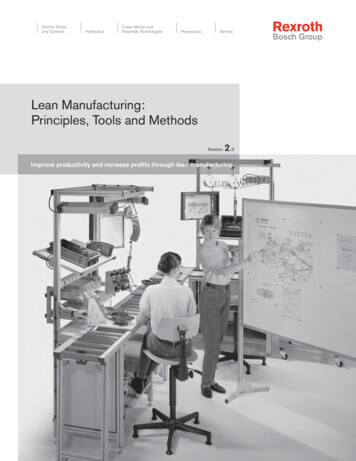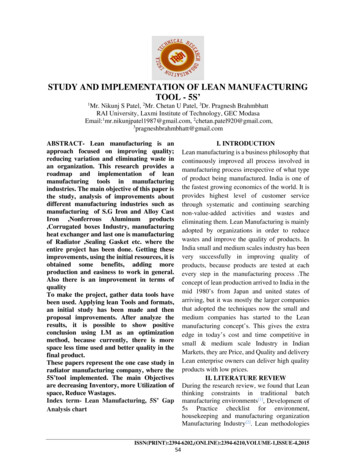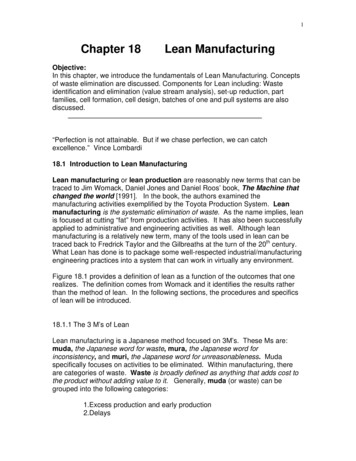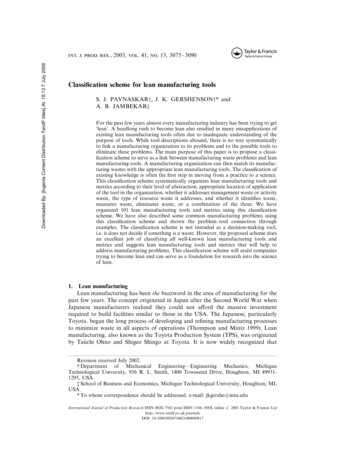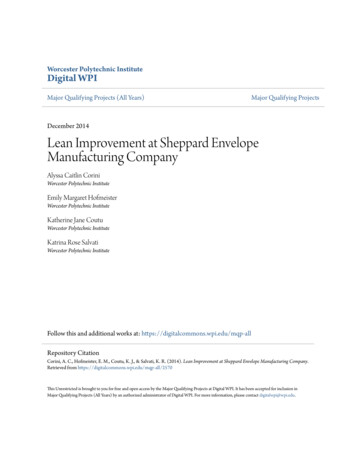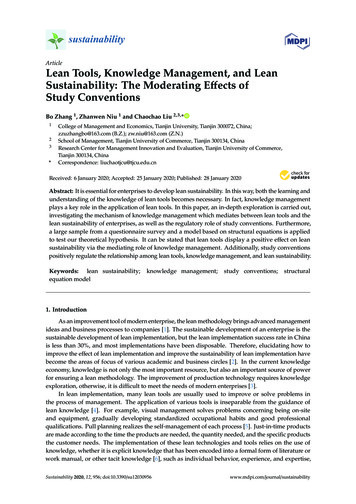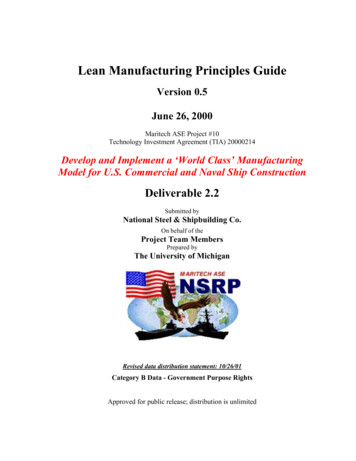
Transcription
Lean Manufacturing Principles GuideVersion 0.5June 26, 2000Maritech ASE Project #10Technology Investment Agreement (TIA) 20000214Develop and Implement a ‘World Class’ ManufacturingModel for U.S. Commercial and Naval Ship ConstructionDeliverable 2.2Submitted byNational Steel & Shipbuilding Co.On behalf of theProject Team MembersPrepared byThe University of MichiganRevised data distribution statement: 10/26/01Category B Data - Government Purpose RightsApproved for public release; distribution is unlimited
Form ApprovedOMB No. 0704-0188Report Documentation PagePublic reporting burden for the collection of information is estimated to average 1 hour per response, including the time for reviewing instructions, searching existing data sources, gathering andmaintaining the data needed, and completing and reviewing the collection of information. Send comments regarding this burden estimate or any other aspect of this collection of information,including suggestions for reducing this burden, to Washington Headquarters Services, Directorate for Information Operations and Reports, 1215 Jefferson Davis Highway, Suite 1204, ArlingtonVA 22202-4302. Respondents should be aware that notwithstanding any other provision of law, no person shall be subject to a penalty for failing to comply with a collection of information if itdoes not display a currently valid OMB control number.1. REPORT DATE2. REPORT TYPE26 JUN 2000N/A3. DATES COVERED-4. TITLE AND SUBTITLE5a. CONTRACT NUMBERLean Manufacturing Principles Guide5b. GRANT NUMBER5c. PROGRAM ELEMENT NUMBER6. AUTHOR(S)5d. PROJECT NUMBER5e. TASK NUMBER5f. WORK UNIT NUMBER7. PERFORMING ORGANIZATION NAME(S) AND ADDRESS(ES)Naval Surface Warfare Center CD Code 2230-Design Integration ToolsBldg 192, Room 128 9500 MacArthur Blvd, Bethesda, MD 20817-57009. SPONSORING/MONITORING AGENCY NAME(S) AND ADDRESS(ES)8. PERFORMING ORGANIZATIONREPORT NUMBER10. SPONSOR/MONITOR’S ACRONYM(S)11. SPONSOR/MONITOR’S REPORTNUMBER(S)12. DISTRIBUTION/AVAILABILITY STATEMENTApproved for public release, distribution unlimited13. SUPPLEMENTARY NOTES14. ABSTRACT15. SUBJECT TERMS16. SECURITY CLASSIFICATION OF:a. REPORTb. ABSTRACTc. THIS PAGEunclassifiedunclassifiedunclassified17. LIMITATION OFABSTRACT18. NUMBEROF PAGESSAR4819a. NAME OFRESPONSIBLE PERSONStandard Form 298 (Rev. 8-98)Prescribed by ANSI Std Z39-18
ByJeffrey K. LikerThomas LambUniversity of MichiganAnn Arbor, MichiganDRAFT, Version 0.5
Table of ContentsA GUIDE TO LEAN SHIPBUILDING1) Introduction2) What is Lean Manufacturinga) The goal: Highest quality, lowest cost, shortest lead timeb) The Toyota Production Systemc) Japanese Shipbuilding as lean manufacturingd) Why change to lean shipbuilding?e) The Lean Shipbuilding Model3) Just In Time “The right part, right time, in right amount”a) Takt time—the pacemaker of the process (balanced cycle times, time windows)b) Continuous Flow (e.g., panel lines, cells in shops, process lanes, stages ofconstruction), e.g., design blocks to come off line at common intervals sobalanced on assembly line.c) Pull Systems (e.g., 40’ cassettes for webs, paletizing and kitting, )i) Supermarket pull systemii) Sequenced Pull (longitudinal stiffners to a panel line using cassetts, leveliii) Balanced Schedules (build to order vs replenish buffers vs schedule)—Bigspikes in demand upstream based on build schedule for final construction. USyards build from ground up and big spikes, e.g., T-Beams. Japanese build inrings from front on back and more uniform demand, but requires accuracycontrol. Cross-trained team moving around the yard another solution.4) Built In Qualitya) Accuracy Controlb) Labor-Machine Balancingc) In-Control Processesd) Visual Controle) Quality Controlf) Worker Self-Quality Controlg) Error Proofing5) Stable Shipyard Processesa) Standard Systemsb) Total Productive Maintenancec) Ergonomics and Safety (ergonomics guide)d) Elimination of Waste6) Learning Organizationa) Flexibilityb) Capabilityc) Motivationd) Continuous Improvement7) Value Chain Integration Copyright 1998, Ford Motor Companyi
a) Integrated Product-Process Development (lean design guide, standard interimproducts)b) Customer Focusc) Supply Chain Integration (JIT)8) Lean Implementation Guidelinesi
IntroductionA shift is occurring in manufacturing around the world. Manufacturers throughout industriesfrom automotive to aircraft to paint to computers to furniture and on and on are moving to adifferent system of production called Lean Manufacturing. We are not talking about addingsome new techniques onto how we now build products, but actually changing the way wethink about manufacturing. That can be a tough shift to make. The best way to understandlean manufacturing is to start with its roots in the Toyota Production System. Toyota startedby following the basic principles set out by Henry Ford with the moving assembly line. Fordpreached the importance of creating continuous material flow, standardizing processes, andeliminating waste. While Ford preached this, his company turned out millions of blackModel-Ts and evolved to wasteful batch production methods of building up huge banks ofwork-in-process inventory throughout the value chain and pushing product onto the nextstage of production. Toyota did not have this luxury, lacking space, money, and the largevolumes of one type of vehicle and the it had to develop a system that flexibly responded tocustomer demand and was efficient at the same time.Shipbuilding is clearly different from automobiles. One does not see a ship coming off theassembly line every minute with relatively standard configurations. Ships are built to order,one or a few at a time over weeks or months and are often highly customized. So is themodel of “lean manufacturing” worth considering? The answer is clearly yes. First, thebasic principles of giving customers what they want with shortened lead times by eliminatingwaste apply to any process, high volume or low volume, customized or standardized. Whilethe particulars of how Toyota applies lean solutions in their circumstances may not all fit, thephilosophy and principles have been fine tuned to a high art form by Toyota. Second, whenworld class shipbuilding models are examined we see much of the same underlyingphilosophy of the Toyota Production System at work in building ships. For example,Japanese shipyards are among the most efficient and have used relatively standardized,modular designs to create what some call ship factories—factories in which there is aconstant flow of basic and intermediate products, built in most cases on moving lines, andmaterial is carefully sequenced and shifted through the yard in a carefully orchestratedflowing pattern—Just-In-Time. Quality is built in at the source, rather than inspected in.Processes are highly standardized and timed. It is the responsibility of each worker, not justa select few inspectors. Raw material, such as steel plates, is not brought into the yardmonths in advance to sit and wait but brought in on a JIT basis.American shipyards have not competed on the world market, instead serving a highlyprotected U.S. defense market. As American shipyards recreate themselves to become morecompetitive they need to rationalize manufacturing and draw on world class manufacturingphilosophies and techniques. It is becoming accepted that the Toyota Production System andthe lean principles that have been derived from this system, in combination with the bestexamples of world class techniques that build on this philosophy, will provide a soundfoundation for the resurgence of American shipyards.This document lays out a framework and some principles for the design of a leanshipbuilding process. The application of these principles depend heavily on how the ship is Copyright 1998, Ford Motor Company3
designed. They assume the ship is designed to be manufacturable and is based on relativelystandardized modules. While each module will not be identical, modules as much as possibleshould be designed to go through common processes and facilitate flow through the yardwithin predictable times.First, the general philosophies of lean manufacturing will be described, specifically focusingon the Toyota Production System. This philosophy and system has been translated into alean shipbuilding model which we will then present. The model provides a framework andthe rest of the guide will be organized around elements of this framework, wherever possibleillustrating the elements with world class shipbuilding examples.What is Lean Manufacturing?The GoalThe Toyota Production System (TPS) was developed to become competitive on worldmarkets, particularly competing with Henry Ford, while addressing the particularcircumstances Toyota faced in Japan. Through years of trial and error on the shopfloorToyota discovered that they could simultaneously achieve high quality, low cost, and just-intime delivery by “shortening the production flow by eliminating waste.” This simple conceptis at the heart of the TPS and what distinguishes it from the older mass production paradigmit supplants. The focus is always on shortening the production flow and waste is anythingthat gets in the way of a smooth flow. The theoretical ideal is continuous one-by-one pieceflow. While this ideal is rarely realized, practitioners of TPS understand directionally thatperformance of the system will improve if the system is moving toward continuous flow byeliminating waste.To understand what this new paradigm of manufacturing of “lean manufacturing” is, it helpsto briefly consider the history of mass production in America and how Toyota’s pathdeviated from that trajectory.1900 to WWIIHenry Ford broke the tradition of craft production by devising mass production to fill theneeds of early 1900's society. A key enabler of mass production was the development ofprecision machine tools and interchangeable parts. Frederick Taylor’s time and motionstudies, in concert with the division of labor into specialized skill groups, led to hugeproductivity increases.The turn of the century was a time of massive growth and movement in the USA. From 1860to 1920 our population more than tripled (31 million to 105 million people). We wereexperiencing massive immigration and migration westward. And many of these peopleneeded a way to move around. They needed vehicles at a low cost, not vehicles for richpeople. There was a big market with unlimited demand. Ford’s response to this situationwas to take advantage of “Economies of Scale” and create the Model T—the car for themasses. Ford’s main innovation was the moving assembly line, which in combination with4
interchangeable parts and time and motion studies revolutionized manufacturing. The cost ofthe Model T dropped from 850 in 1908 to 290 in 1925. An amazing 15 million were sold.The rest is history.In the meantime, over in Japan, the Toyoda family was making automatic weaving looms.Toyoda's inventions included special mechanisms to automatically stop a loom whenever athread broke. Toyoda sold these patent rights to the Platt Brothers in England for 100,000English pounds, and in 1930 used that capital to start building the Toyota Motor Corporation.Toyota Motor Corporation started out primarily making simple trucks, and struggled for mostof the pre-WWII period. Toyota produced poor vehicles and had little success. (e.g.:hammering body panels over logs)However, Toyota did visit Ford and GM in 1930, to study their assembly lines. Toyotamanagers carefully read Henry Ford's books, and tested the conveyor system, precisionmachine tools, and the economies of scale idea in their loom production. Toyota realizedearly on that the Japanese market was too small and fragmented to support the highproduction volumes we had in the USA. (A U.S. auto line might produce 9,000 units permonth, while Toyota would produce only about 900 units per month.) Toyota knew theywould have to alter the mass production approach for the Japanese market.POST-WWIIWWII and its aftermath brought auto production at Toyota to a near standstill, but broughtboom times again in the USA. Plants were running at capacity almost a repeat of the earlierbig market & big demand! Mass ideas became cemented due to great financial success.Mass production techniques introduced by Ford became universally used across U.S. andEurope. This is illustrated in Figure 1.Figure 1: Post-War History of TPSMass Production spreads and tries to adapt to changes.Lean Manufacturing emerges as the alternative.Increasingly ComplexVehicles and DiverseMarketPostwar Boom(Mass ideascemented in)Ford SystemEmphasis onFinance andAccountingLarge-Lot ProductionSmall MarketFew ResourcesNeed CashLousy QualityAutomationU.S. Consumers look forsmaller cars. Big 3Market share declinebegins.1st OilShockTOYOTA“Catch upwithU.S.A!”Toyota Automatic Loom“Jidoka”1945 Copyright 1998, Ford Motor CompanyTOYOTAPRODUCTIONSYSTEMJapanese industry, Fantasticrecognizes TPS & Success!dissemination beginsSupermarketSystem1973198025
Henry Ford was clearly a manufacturing genius and in fact his early writings (for example,Today and Tomorrow, published in 1926) clearly laid out all the basic concepts of leanmanufacturing. The famous River Rouge complex in Dearborn was designed to flowmaterials from iron ore to finished vehicles and Henry Ford wrote that large batch productionwith lots of inventory everywhere is waste. Yet, batch production was exactly what waspracticed at the River Rouge, and despite the waste the huge demand and large volumesmade Ford profitable despite all the waste."Ford made a dramatic wrong turn at his new Rouge complex. He maintained the assemblytrack but rearranged his fabrication machinery into process villages. He proceeded to run apush schedule in which growing fluctuations in end-customer demand and persistent hiccupsin upstream production were buffered by a vast bank of finished units forced on the dealernetwork and equally vast buffers of parts at ev
26.06.2000 · Lean Manufacturing Principles Guide Version 0.5 June 26, 2000 Maritech ASE Project #10 Technology Investment Agreement (TIA) 20000214 Develop and Implement a ‘World Class’ Manufacturing Model for U.S. Commercial and Naval Ship Construction Deliverable 2.2 Submitted by National Steel & Shipbuilding Co. On behalf of the Project Team Members Prepared by The University
